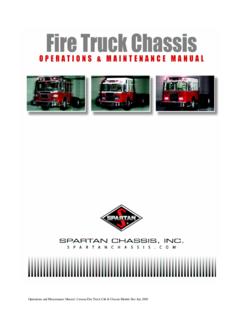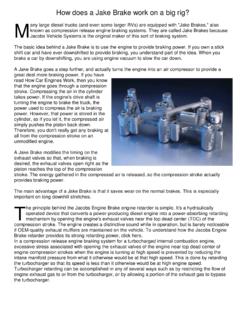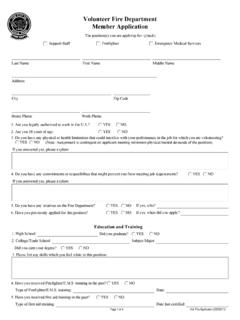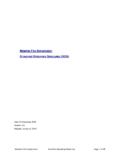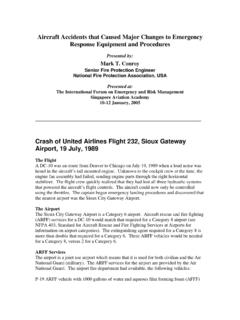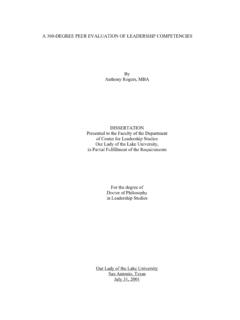Transcription of CHAINSAW TRAINING PROGRAM - Swannanoa …
1 1 CHAINSAW TRAINING PROGRAM Revision PART 1 Swannanoa VOLUNTEER fire department 2 Section 1; Introduction CHAINSAW use during wildland fire fighting operations and storm clean-up is one of the single most dangerous tasks that can be assigned to any person. Many firefighters, public works personnel, and home owners are injured and killed every year while operating chainsaws. With proper TRAINING , experience and an increased state of awareness you greatly reduce your chances of being injured or killed. This manual is intended to be an introductory guide to the proper use and maintenance of the chainsaws employed at the Swannanoa fire department . Though this manual will not teach you the skill and awareness that comes with ongoing TRAINING and experience, it will present you with the basics of CHAINSAW operation.
2 Safety Safety is the number one priority when operating a CHAINSAW . Regardless of other factors you should always wear proper PPE. Even in a situation that will only take seconds or minutes to complete, it can only take seconds to be seriously injured or killed during while operating saw. PPE is just as important as it is with any other hazardous situation that we encounter. You would not enter a structure fire without proper turnout gear, or a dive rescue without proper SCUBA gear and you should not operate a CHAINSAW without the correct gear. Every year experienced and inexperienced saw operators are killed and seriously injured. According to the Consumer Products Safety Commission there were over 30,000 CHAINSAW injuries in 2007.
3 More than 36% were to the legs and knees. It is estimated that the average CHAINSAW injury takes 110 stitches and can cost $5, for medical care. It is estimated that in 2008 the cost will be over $12,000 per injury. This brings the cost of CHAINSAW injuries to over $400,000 per year. The loss of production and loss of quality of life for the injured cannot be adequately quantified but, may in fact be the single largest cost. 3 There are 69,000 loggers in the United States today and the cost of equipping them all with one pair of chaps at an estimate of $ a pair would be almost million dollars. We could only try to imagine how many people in the US operate a CHAINSAW without proper PPE.
4 There are few situations where safety has a more immediate payback than in both the logging industry and fire and rescue itself. Safety is number one; we live by that premise, operate by it, and train by it. Safety has no holiday and this is one situation where we should never let our guard down. Even if it takes longer to prepare for the job than to do the job we have saved ourselves thousands of dollars and unthinkable amounts in the quality of life. Checklist of Personal Safety Considerations and Attitude How do I feel about this sawing assignment? Am I exercising sound judgment and awareness? Is my attitude influencing me to go against my better judgment (gut feeling)?
5 Is my mind on my work project or activity? Do I have self-confidence? Am I overconfident? Am I doing this against my will? Is peer pressure a factor? Am I professional enough to decline the assignment and ask for assistance? Do I have all of the required PPE and sawing equipment to do the job safely? Am I committed to using the PPE and equipment correctly? Am I complacent? Am I violating any safe operating procedures? Do I feel hurried or unusually stressed to get the tree on the ground or bucked? Have all options been considered and discussed with others? Am I in an unfamiliar environment and timber type? Do I watch out for my coworkers, contractors, and the public?
6 4 PPE for Operating a CHAINSAW Hard hat The department issued hard hat protects you from falling branches, limbs and anything the saw may kick up towards your head. In addition to the hard hats issued by the department you may see helmets with a screen and hearing protection attached. Ear protection Ear protection is essential while operating the saw. Some sawyers pull one ear protector away from the ear or wear one ear plug to listen for sounds the tree will make while sawing. This is not reccomended as long term exposure to loud sounds will cause hearing loss. Eye protection While sawing you will have burning embers, branches, saw dust, bar oil and leaves/needles seemingly always coming at your face and your eyes in particular.
7 Only use eye wear that is ANSI certified (including Oakley sunglasses) when using the saw. Long Sleeve shirt When using saws you must protect your arms from debris; this can be accomplished with your yellow Nomex shirt, bunker coat, or flannel type shirt. Gloves The most common place to receive burns, cuts and scrapes is your hands. Make sure they are protected by gloves at all times, whether you are running the saw or sharpening the teeth. Long pants - Ensure you have long pants (green Nomex, bunker, or jeans) on while operating a saw. If wearing bunker pants chaps will also be worn as the bunker paints will not provide the protection to legs and waist as chaps will.
8 Boots You must wear footwear designed to prevent injury due to falling or rolling objects and objects piercing the soles. Heavy-duty, cut-resistant or leather, 8-inch-high laced boots with nonskid soles are required for chain saw use. Chaps Protect the operator from saw cuts to the legs. Chaps have a nylon shell covering multiple layers of loose Kevlar fiber. The chaps should be kept clean and must not be stored in compartments with gas and oil. When chaps become saturated with oil, bar oil, and gas they should replaced do to the flammability during a wildland fire . 5 How do chain saw chaps protect the user when a chain saw strikes chain saw chaps? Kevlar fibers first resist the cut, and then are pulled into the chain saws drive sprocket, slowing and quickly stopping the chain (approximately five seconds or less).
9 If the chap surface or pad is cut, it cuts the Kevlar fibers. If another cut occurs it will only pull out the Kevlar strands that have been previously damaged, resulting in increased chance of injury. When a cut occurs the chaps should be inspected by the Safety Officer and if need be taken out of service. Chaps are only sewn along the edges to ensure the maximum amount of fabric will pull out to clog the chain and sprocket. A back-coated nylon shell covers the Kevlar protective pad inside the chaps. The shell resists water, oil, and abrasions. The protective pad consists of five layers of Kevlar. Kevlar is an Aramid fiber similar to the Nomex material used in firefighter s clothing.
10 When chain saw chaps are exposed to temperatures higher than 500 degrees Fahrenheit, the nylon shell may melt, but the protective Kevlar pad will not burn. Chain saw chaps need to be properly adjusted and worn snug to keep them positioned correctly on the legs. Proper fit and correct length (two inches past the boot top or clear to the instep) maximize protection. Inspection and replacement Chain saw chaps need to be inspected and replaced when appropriate. Replace chain saw chaps when: a. The outer shell has numerous holes and cuts. Holes in the outer shell allow bar oil to be deposited on the protective pad. The oil acts as an adhesive, preventing fibers in the pad from moving freely, and decreasing protection.
